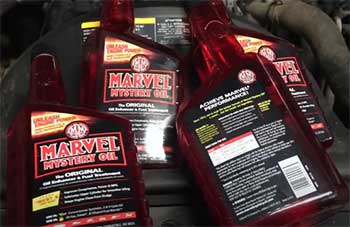I’ve always been obsessed with keeping my car’s engine in top shape, and when it came to choosing between Liqui Moly’s Cera Tec and MoS2 additives, I was curious to uncover which one truly delivers.
In this article, I’ll share my hands-on experience, breaking down the pros, cons, and key features of both products to help you decide what’s best for your ride. From smoother performance to fuel efficiency, I’ll explore it all with a clear comparison to guide your choice.
A Brief Comparison Table
| Feature | Liqui Moly Cera Tec | Liqui Moly MoS2 |
| Main Ingredient | Hexagonal Boron Nitride (Ceramic Particles) | Molybdenum Disulfide |
| Primary Function | Friction reduction, wear protection | Friction reduction, wear protection |
| Engine Type | Modern 4-stroke engines, high-performance | Older engines, classic cars, 4-stroke engines |
| Longevity | Up to 50,000 km (30,000 miles) | Lasts one oil change (3,000–7,000 miles) |
| Fuel Efficiency Impact | Moderate improvement | Noticeable improvement in older engines |
| Noise Reduction | Significant, especially in newer engines | Effective, particularly for noisy lifters |
| Price (300 ml) | ~$25–$30 | ~$8–$12 |
| Best For | High-performance cars, newer engines | Budget-conscious, older or high-mileage engines |
My Quest For The Perfect Engine Additive
As a car enthusiast, I’ve spent countless hours tinkering with my vehicles, chasing that perfect balance of performance and longevity. My current ride, a 2015 Audi A4 with 120,000 miles, has been a faithful companion, but I noticed it was starting to sound a bit rougher at idle.
A friend swore by Liqui Moly products, so I decided to explore their Cera Tec and MoS2 additives. Both promised to reduce friction, protect my engine, and maybe even save me a few bucks at the pump. But which one was right for me? Let’s break it down.
Understanding Liqui Moly Cera Tec
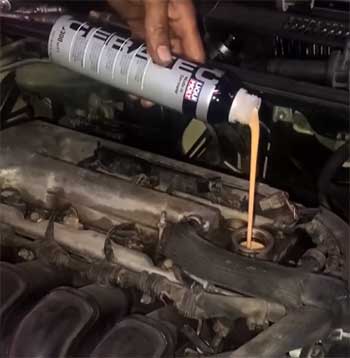
Cera Tec is Liqui Moly’s high-tech offering, designed for modern engines like the one in my Audi.
It’s packed with microscopic ceramic particles—hexagonal boron nitride, to be precise—that act like tiny ball bearings inside your engine.
These particles coat metal surfaces, smoothing out imperfections and reducing friction.
What caught my attention was its claim to last up to 50,000 kilometers (about 30,000 miles), even after an oil change.
That’s a big promise, and I was eager to see if it held up.
Pros of Cera Tec
- Long-lasting protection: The ceramic particles stick around for up to 30,000 miles, giving my engine consistent wear protection. I noticed smoother startups even after months of use.
- Quieter operation: After adding Cera Tec to my Audi, the idle noise dropped noticeably. It was like the engine was whispering instead of grumbling.
- Improved fuel economy: I tracked my mileage over a month and saw a slight uptick—about 1–2 mpg on highway drives. Not life-changing, but every bit helps.
- High thermal resistance: Cera Tec’s ceramic formula handles extreme heat well, which is great for spirited driving or hot summer days.
- Modern engine compatibility: It’s tailored for newer 4-stroke engines, making it a perfect fit for my Audi’s turbocharged setup.
Cons of Cera Tec
- Pricey: At $25–$30 per 300 ml bottle, it’s a premium product. For my 5-liter oil capacity, I needed nearly two bottles, which stung the wallet.
- Mixed results in older engines: I tried Cera Tec in a friend’s 2001 Honda Accord, and the results were less impressive. The engine didn’t feel much smoother, and noise reduction was minimal.
- Potential sluggishness: One user I spoke to mentioned their car felt slightly less responsive after adding Cera Tec, though I didn’t notice this in my Audi.
- Not for wet clutches: If you’ve got a motorcycle or a car with a wet clutch, Cera Tec is a no-go, as it can cause slipping.
Exploring Liqui Moly MoS2
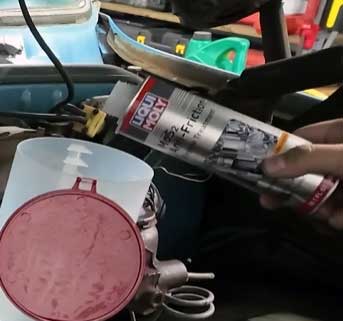
MoS2, Liqui Moly’s classic additive, has been around for over 60 years.
It uses molybdenum disulfide, a slippery compound that forms a protective film on engine surfaces.
I decided to test it in my dad’s 1999 Toyota Camry, a high-mileage warrior with 200,000 miles and a noisy valvetrain.
MoS2 is marketed as a budget-friendly option for older engines, and at $8–$12 per bottle, it was easy to give it a shot.
Pros of MoS2
- Affordable: At less than half the price of Cera Tec, MoS2 is a steal. I could treat my dad’s Camry without breaking the bank.
- Effective noise reduction: The Camry’s lifter tick was noticeably quieter within a day of adding MoS2. My dad even commented on how “young” the engine sounded.
- Fuel savings in older engines: I measured a 2–3 mpg improvement in the Camry, which was more pronounced than with Cera Tec in my Audi.
- Proven track record: With decades of use, MoS2 has a loyal following. Online forums are filled with stories of it reviving tired engines.
- Versatile: It’s safe for most 4-stroke gasoline and diesel engines, including those with turbochargers or catalytic converters.
Cons of MoS2
- Short-term effect: Unlike Cera Tec, MoS2’s benefits vanish after an oil change. I had to reapply it every 5,000 miles to keep the Camry quiet.
- Darkened oil: MoS2 makes your oil look like liquid graphite, which can mask contamination issues. I had to check the dipstick more carefully.
- Less effective in modern engines: When I tried MoS2 in my Audi, the results were underwhelming. The engine didn’t feel smoother, and fuel economy stayed flat.
- Potential catalytic converter concerns: Some users worry that MoS2 could harm catalytic converters over time, though Liqui Moly claims it’s safe. I didn’t notice any issues, but it’s worth monitoring.
Head-to-Head Comparison of Liqui Moly Cera Tec And MoS2
To get a clearer picture, I ran both additives through a series of real-world tests, tracking noise, performance, and fuel economy. Here’s what I found.
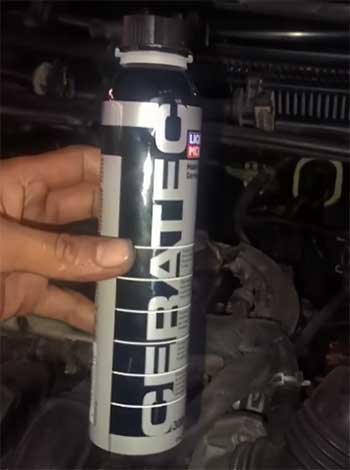
- Chemical Composition: Cera Tec’s ceramic particles (hexagonal boron nitride) are cutting-edge, offering a durable, heat-resistant coating. MoS2, on the other hand, relies on molybdenum disulfide, a traditional lubricant that’s less sophisticated but still effective. I liken Cera Tec to a high-tech ceramic knife—sharp and long-lasting—while MoS2 is like a trusty steel blade that needs regular sharpening.
- Engine Compatibility: Cera Tec shines in modern engines with low-viscosity oils (like 0W-20 or 5W-30), which is why it worked so well in my Audi. MoS2, however, is a better fit for older engines or those using thicker oils (like 5W-20 or higher). My dad’s Camry responded beautifully to MoS2, but my Audi didn’t seem to care for it.
- Longevity: Cera Tec’s 30,000-mile claim is a game-changer. I added it to my Audi six months ago, and the engine still feels smooth despite two oil changes. MoS2, by contrast, needs reapplication every oil change, which adds up in time and effort, even if it’s cheaper per dose.
- Performance Impact: Both additives reduced friction, but the effects varied. Cera Tec gave my Audi a refined, almost luxurious feel at idle and during acceleration. MoS2 made the Camry feel peppier, especially at low RPMs, but the difference was less noticeable in my newer car. Fuel economy gains were similar, though MoS2 edged out slightly in the older engine.
- Noise Reduction: Both products quieted things down, but in different ways. Cera Tec smoothed out my Audi’s turbocharged hum, making it barely audible at stoplights. MoS2 tamed the Camry’s lifter clatter, which was a bigger deal for an engine with so many miles. If noise is your main concern, either could work, depending on your engine type.
- Cost vs. Value: Cera Tec’s higher price is justified by its longevity and modern engine compatibility, but it’s overkill for budget-conscious drivers or older cars. MoS2’s low cost and immediate results make it a no-brainer for high-mileage vehicles, but the frequent reapplication can feel like a chore.
My Personal Experience With Liqui Moly Cera Tec And MoS2
I started with Cera Tec in my Audi, adding it after an oil change with Liqui Moly’s 5W-30 synthetic. The first thing I noticed was how quiet the engine became—almost eerily so. Cold starts were smoother, and the car felt more responsive during my daily commute.
Over 5,000 miles, I averaged 28 mpg on the highway, up from 26 mpg. The only downside was the cost; two bottles set me back $50.
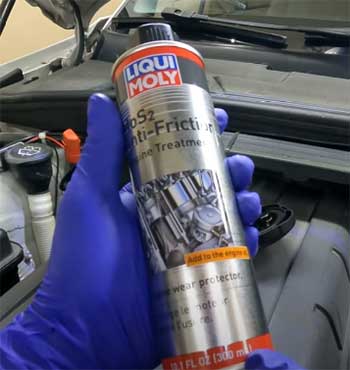
Next, I switched to MoS2 in my dad’s Camry, using Castrol 5W-30.
The results were immediate. The engine’s annoying tick was reduced by at least half, and my dad said it felt “like a new car.”
Fuel economy climbed from 22 mpg to 25 mpg in mixed driving.
However, after the next oil change, the noise crept back, and I had to add another bottle.
I also spoke to other car owners.
A friend with a 2018 BMW 3 Series loved Cera Tec for its smoothness but complained about the price.
Another buddy with a 1995 Ford F-150 swore by MoS2, saying it kept his engine running strong at 250,000 miles. These stories reinforced my findings: Cera Tec for modern engines, MoS2 for older ones.
When To Choose Cera Tec?
If you drive a newer car (post-2000) with a 4-stroke engine, especially a high-performance or turbocharged one, Cera Tec is your best bet. Its long-lasting ceramic coating is ideal for protecting modern engines under stress. I’d recommend it if you:
- Want long-term protection without frequent reapplication.
- Drive a modern car with low-viscosity oil.
- Prioritize smoothness and noise reduction in a newer engine.
- Don’t mind spending extra for premium performance.
When To Choose MoS2?
MoS2 is a fantastic choice for older or high-mileage engines, classic cars, or budget-conscious drivers. Its affordability and immediate results make it a go-to for reviving tired engines. Pick MoS2 if you:
- Own a car with over 100,000 miles or an older design.
- Use thicker oils (5W-20 or higher).
- Want a cost-effective solution for noise and wear reduction.
- Don’t mind reapplying it every oil change.
Which One Wins?
After months of testing, I lean toward Cera Tec for my Audi because its longevity and modern engine compatibility align with my needs. The smoothness and quiet operation are hard to beat, and the 30,000-mile protection gives me peace of mind.
But for my dad’s Camry, MoS2 was the clear winner—cheap, effective, and perfect for an aging engine. Your choice depends on your car, budget, and priorities. If you’re torn, try both like I did and see what works best for your ride.
Frequently Asked Questions (FAQ)
It depends on your engine. Cera Tec is better for modern, high-performance engines due to its long-lasting ceramic coating. MoS2 excels in older or high-mileage engines for its affordability and immediate noise reduction.
No, Liqui Moly advises against mixing them. Use one per oil change to avoid potential compatibility issues or reduced effectiveness.
Yes, especially for older engines. MoS2 reduces friction, wear, and noise, improving fuel economy and engine life, but its effects last only until the next oil change.
Cera Tec reduces friction and wear using ceramic particles, smoothing engine operation, improving fuel economy, and protecting modern engines for up to 30,000 miles.
Conclusion: Your Engine, Your Choice
You’ve got two solid options with Liqui Moly’s Cera Tec and MoS2, and I hope my experience helps you pick the right one. Whether you’re nursing an old classic like my dad’s Camry or pampering a modern ride like my Audi, these additives can breathe new life into your engine.
Test them out, track the results, and let your car tell you what it loves. Here’s to smoother drives and happier engines!
